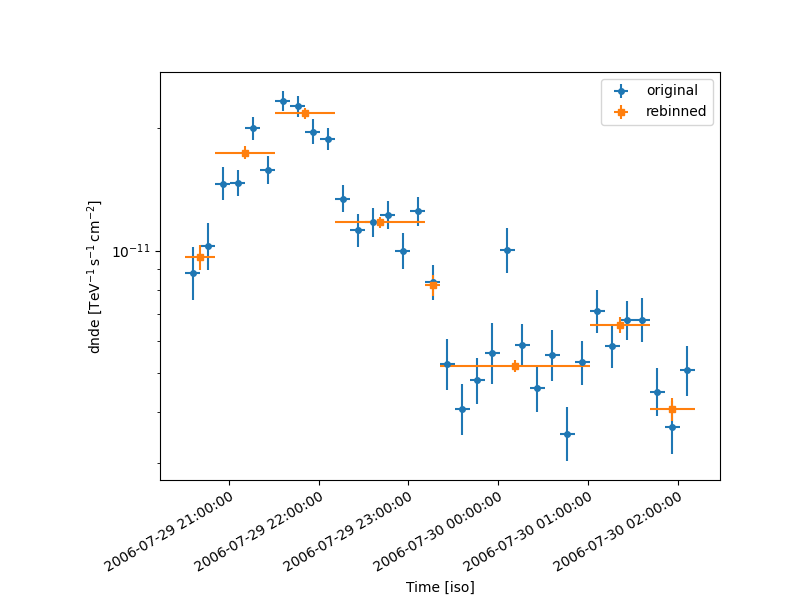Note
Go to the end to download the full example code or to run this example in your browser via Binder.
Estimation of time variability in a lightcurve#
Compute a series of time variability significance estimators for a lightcurve.
Prerequisites#
Understanding the light curve estimator, please refer to the Light curves tutorial. For more in-depth explanation on the creation of smaller observations for exploring time variability, refer to the Light curves for flares tutorial.
Context#
Frequently, after computing a lightcurve, we need to quantify its variability in the time domain, for example in the case of a flare, burst, decaying light curve in GRBs or heightened activity in general.
There are many ways to define the significance of the variability.
Objective: Estimate the level time variability in a lightcurve through different methods.
Proposed approach#
We will start by reading the pre-computed light curve for PKS 2155-304 that is stored in $GAMMAPY_DATA
To learn how to compute such an object, see the Light curves for flares tutorial.
This tutorial will demonstrate how to compute different estimates which measure the significance of variability. These estimators range from basic ones that calculate the peak-to-trough variation, to more complex ones like fractional excess and point-to-point fractional variance, which consider the entire light curve. We also show an approach which utilises the change points in Bayesian blocks as indicators of variability.
Setup#
As usual, we’ll start with some general imports…
import numpy as np
from astropy.stats import bayesian_blocks
from astropy.time import Time
import matplotlib.pyplot as plt
from gammapy.estimators import FluxPoints
from gammapy.estimators.utils import (
compute_lightcurve_doublingtime,
compute_lightcurve_fpp,
compute_lightcurve_fvar,
)
from gammapy.maps import TimeMapAxis
Load the light curve for the PKS 2155-304 flare directly from $GAMMAPY_DATA/estimators.
lc_1d = FluxPoints.read(
"$GAMMAPY_DATA/estimators/pks2155_hess_lc/pks2155_hess_lc.fits", format="lightcurve"
)
plt.figure(figsize=(8, 6))
plt.subplots_adjust(bottom=0.2, left=0.2)
lc_1d.plot(marker="o")
plt.show()

Methods to characterize variability#
The three methods shown here are:
amplitude maximum variation
relative variability amplitude
variability amplitude.
The amplitude maximum variation is the simplest method to define variability (as described in Boller et al., 2016) as it just computes the level of tension between the lowest and highest measured fluxes in the lightcurve. This estimator requires fully Gaussian errors.
flux = lc_1d.flux.quantity
flux_err = lc_1d.flux_err.quantity
f_mean = np.mean(flux)
f_mean_err = np.mean(flux_err)
f_max = flux.max()
f_max_err = flux_err[flux.argmax()]
f_min = flux.min()
f_min_err = flux_err[flux.argmin()]
amplitude_maximum_variation = (f_max - f_max_err) - (f_min + f_min_err)
amplitude_maximum_significance = amplitude_maximum_variation / np.sqrt(
f_max_err**2 + f_min_err**2
)
print(amplitude_maximum_significance)
[[[12.41584196]]]
There are other methods based on the peak-to-trough difference to assess the variability in a lightcurve. Here we present as example the relative variability amplitude as presented in Kovalev et al., 2004:
relative_variability_amplitude = (f_max - f_min) / (f_max + f_min)
relative_variability_error = (
2
* np.sqrt((f_max * f_min_err) ** 2 + (f_min * f_max_err) ** 2)
/ (f_max + f_min) ** 2
)
relative_variability_significance = (
relative_variability_amplitude / relative_variability_error
)
print(relative_variability_significance)
[[[19.613114]]]
The variability amplitude as presented in Heidt & Wagner, 1996 is:
variability_amplitude = np.sqrt((f_max - f_min) ** 2 - 2 * f_mean_err**2)
variability_amplitude_100 = 100 * variability_amplitude / f_mean
variability_amplitude_error = (
100
* ((f_max - f_min) / (f_mean * variability_amplitude_100 / 100))
* np.sqrt(
(f_max_err / f_mean) ** 2
+ (f_min_err / f_mean) ** 2
+ ((np.std(flux, ddof=1) / np.sqrt(len(flux))) / (f_max - f_mean)) ** 2
* (variability_amplitude_100 / 100) ** 4
)
)
variability_amplitude_significance = (
variability_amplitude_100 / variability_amplitude_error
)
print(variability_amplitude_significance)
[[[6.12525306]]]
Fractional excess variance, point-to-point fractional variance and doubling/halving time#
The fractional excess variance, as presented by
Vaughan et al., 2003, is
a simple but effective method to assess the significance of a time variability feature in an object,
for example an AGN flare. It is important to note that it requires Gaussian errors to be applicable.
The excess variance computation is implemented in utils.
fvar_table = compute_lightcurve_fvar(lc_1d)
print(fvar_table)
min_energy max_energy ... fvar_err significance
TeV TeV ...
------------------ ----------------- ... ------------------- ------------------
0.5915030546513255 6.184989894219835 ... 0.01700709977114979 33.082691868487906
A similar estimator is the point-to-point fractional variance, as defined by Edelson et al., 2002, which samples the lightcurve on smaller time granularity. In general, the point-to-point fractional variance being higher than the fractional excess variance is indicative of the presence of very short timescale variability.
fpp_table = compute_lightcurve_fpp(lc_1d)
print(fpp_table)
min_energy max_energy ... fpp_err significance
TeV TeV ...
------------------ ----------------- ... -------------------- ----------------
0.5915030546513255 6.184989894219835 ... 0.017442925431194484 15.2995484265169
The characteristic doubling and halving time of the light curve, as introduced by Brown, 2013, can also be computed. This provides information on the shape of the variability feature, in particular how quickly it rises and falls.
dtime_table = compute_lightcurve_doublingtime(lc_1d, flux_quantity="flux")
print(dtime_table)
min_energy max_energy ... halving_err halving_coord
TeV TeV ... s
------------------ ----------------- ... ------------------ -----------------
0.5915030546513255 6.184989894219835 ... 254.20638402061059 53946.00422666667
Bayesian blocks#
The presence of temporal variability in a lightcurve can be assessed by using bayesian blocks
(Scargle et al., 2013).
A good and simple-to-use implementation of the algorithm is found in
astropy.stats.bayesian_blocks.
This implementation uses Gaussian statistics, as opposed to the
first introductory paper
which is based on Poissonian statistics.
By passing the flux and error on the flux as measures to the method we can obtain the list of optimal bin edges
defined by the bayesian blocks algorithm.
time = lc_1d.geom.axes["time"].time_mid.mjd
bayesian_edges = bayesian_blocks(
t=time, x=flux.flatten(), sigma=flux_err.flatten(), fitness="measures"
)
The result giving a significance estimation for variability in the lightcurve is the number of change points, i.e. the number of internal bin edges: if at least one change point is identified by the algorithm, there is significant variability.
ncp = len(bayesian_edges) - 2
print(ncp)
7
We can rebin the lightcurve to compute the one expected with bayesian edges.
First, we adjust the first and last bins of the bayesian_edges to coincide
with the original light curve start and end points.
Create a new axis:
axis_original = lc_1d.geom.axes["time"]
bayesian_edges[0] = axis_original.time_edges[0].value
bayesian_edges[-1] = axis_original.time_edges[-1].value
edges = Time(bayesian_edges, format="mjd", scale=axis_original.reference_time.scale)
axis_new = TimeMapAxis.from_time_edges(edges[:-1], edges[1:])
Rebin the lightcurve:
Plot the new lightcurve on top of the old one:
plt.figure(figsize=(8, 6))
plt.subplots_adjust(bottom=0.2, left=0.2)
ax = lc_1d.plot(label="original")
resample.plot(ax=ax, marker="s", label="rebinned")
plt.legend()
plt.show()

